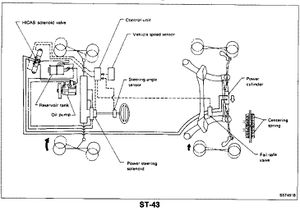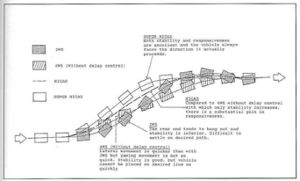HICAS
Mode of Operation
HICAS activates at about 55mph and self-disables at 125mph. When quickly entering a turn, the rear wheels briefly turn in-phase with the front wheels. As soon as the driver counter-steers (to straighten or enter the next turn), the rear wheels shift and turn counter-phase to the front wheels. By allowing the rear to turn counter-phase to the front wheels in a controlled manner, it helped to prevent the rear from stepping out and fish-tailing. Because the system could continue to turn the rear wheels counter-phase, it made the Z32 handle exceptionally well through a slalom (or quick, connecting opposite turns), which was considered an important feature of many publication's driving tests during the time of the Z32's release.
Early Style
From 1990 to 1993, HICAS was hydraulically actuated by means of the power steering system. Two solenoids in the engine bay were connected to two hydraulic lines that ran to the HICAS steering rack at the back of the car. The HICAS rack was a cylindrical rack with a tie-rod on either side, like a conventional steering rack. Internally, it had a large diaphragm (connected to the tie rods) in the center, with a springs on either side pushing towards each other (to keep the rack centered). When the solenoids in the engine bay opened, they allowed hydraulic pressure through the lines to either side (left or right) of the HICAS rack. With the additional pressure, one side would "overpower" the spring in the other side of the rack, and allow the rack to move to one side, bringing the tie rods with it. The rack would turn the wheels up to one degree in either direction. By controlling the pulse width of the actuation solenoids, the HICAS control unit could change the amount of fluid pressurizing in the lines and thus the steering angle of the rear wheels.
Late Style
In 1994, the Z32 switched to an electric version of HICAS. Aside from the front steering rack, the entire power steering system in the TT then became identical to that found in the NA (all years), heavily simplifying the engine bay. This newer version used electric motors at the rear of the car to actuate the rear HICAS rack.
There are two versions of HICAS: HICAS and SuperHICAS. While functionally almost the same (the SuperHICAS system was more "aggressive" with it's control over the rear wheels), it is not made clear whether HICAS and SuperHICAS respectively refer to the hydraulic and electric versions of the system, or if the Z32's implementations should all be referred to as SuperHICAS (with HICAS being an earlier system, employed in the older R31 Skyline and some other Japan-only Nissans).
Criticisms
For day-to-day commutes, most drivers never even notice the HICAS system. Nissan was able to justify it due to the added safety in preventing fishtailing during emergency maneuvers, and while it arguably helps the Z32 handle slightly better, those who take their Zs to the track often complain of a "vague" feeling from the rear end, due to HICAS trying to keep the rear wheels planted. Some even say that the HICAS system adds an element of unpredictability that actually makes the car more dangerous, and difficult to control during hard cornering. For these reasons, many owners delete the HICAS system from their cars. This can be done by using a HICAS Elminator Bar and removing/capping the power steering lines (on 90-93 cars). Some go so far to convert the power steering pump and lines to use parts from an NA, for added simplicity.

